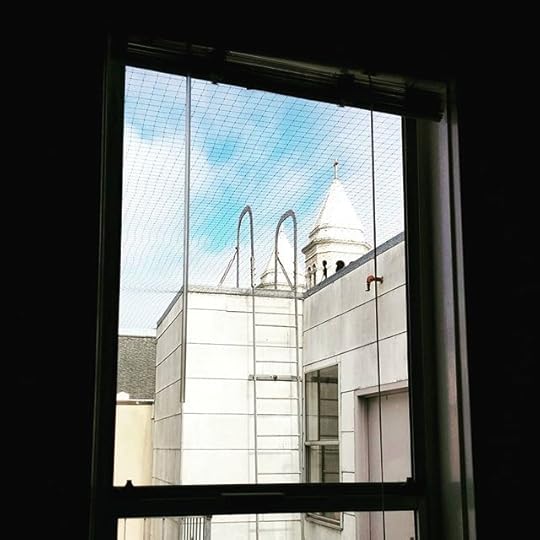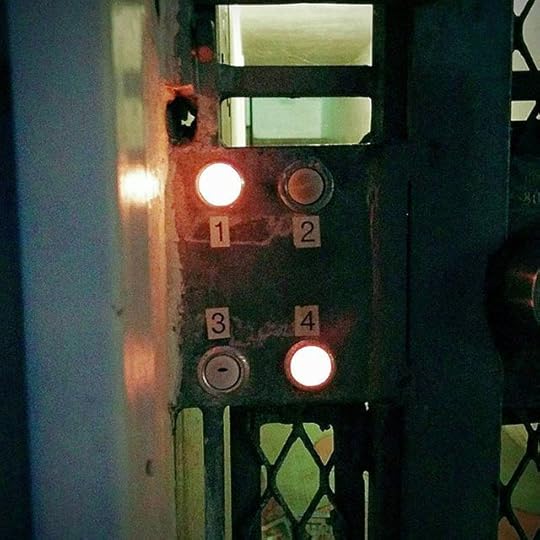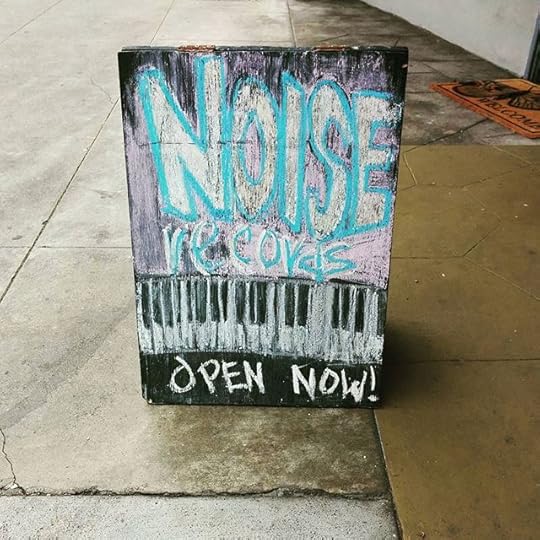Marc Weidenbaum's Blog, page 369
August 3, 2015
Singing Bowls

The singing bowls of Jason Charney’s recent sound installation can challenge your speakers, and your ears. They can draw you in with their textured, sinuous waves, only to suddenly veer north into a piercing high register. Use headphones with caution, and start at a low volume. But all those caveats aside, the work is a must listen.
The track is a document of his half-dozen-plus steel bowls, set to trigger themselves. The result is a quasi-random series of overlaid signals, which on occasion take on a focused sequence akin to considered composition.
Writes Charney of his procedure:
A contact microphone and transducer attached to the bottom of each bowl creates a feedback loop, turning these bowls into resonant objects that play themselves. A computer listens and adjusts the signal flow to create a variety of sonic results. The sounds of visitors walking around the room or ambient noise from the space adds slight variation to the signal chain, magnified by the exponential nature of a feedback loop.
The work was exhibited at Eastern Bloc in Montréal, Canada, as part of Montréal Contemporary Music Lab 2015. Track originally posted at soundcloud.com/jasoncharney. More from Charney at twitter.com/jcharney and jasoncharney.com.
July 31, 2015
What Sound Looks Like

This being San Francisco, when rent on my #noiseoffice went up over 50%, I figured that was part of the price of being in the city. But then friends and colleagues started directing me toward more cost-efficient options, and in the end much of what my current office’s rent included (shared conference room, waiting area, bathroom with shower) wasn’t all that necessary for me. Surprisingly quickly, I lucked out and found a place that was 40% less than my current rent (do the math regarding how much less that is than my projected rent). Anyhow, the new spot is also about 50% larger than my previous office, though lacking in some of the amenities (no street view, fewer windows, carpet instead of wood floors). For local flavor’s sake, my new office is in between that of a massage therapist and a crematorium. They don’t have an oven in the crematorium office — they just hold meetings there. This shot is the view out the one window in my office. The building neighbors a local church, whose bells ring clearly at 5pm, and likely other times of the day — when exactly I’ll find out after I move in.
An ongoing series cross-posted from instagram.com/dsqt.
July 30, 2015
Disquiet Junto Project 0187: Three Strands

Each Thursday in the Disquiet Junto group on SoundCloud.com and at disquiet.com/junto, a new compositional challenge is set before the group’s members, who then have just over four days to upload a track in response to the assignment. Membership in the Junto is open: just join and participate.
This assignment was made in the evening, California time, on Thursday, July 30, 2015, with a deadline of 11:59pm wherever you are on Monday, August 3, 2015.
These are the instructions that went out to the group’s email list (at tinyletter.com/disquiet-junto):
Disquiet Junto Project 0187: Three Strands
Shift between three renditions of the same melody.
Step 1: Choose a simple melody/song/rhythm of your own creation, or that is in the public domain (or that is available thanks to an appropriate Creative Commons license).
Step 2: Record yourself performing the melody/song/rhythm from Step 1 three times, each time with a different instrument or set of instruments. Each of the three resulting tracks should be the same length, at least a full minute. (A single track can be a concatenation of multiple copies of the same recording of the segment — you don’t have to play it straight through for the full minute.)
Step 3: Make a new recording of the three tracks playing simultaneously. The only thing you can do throughout is shift between the tracks, playing either one of them, two of them, or all three of them at the same time. You can shift every few bars, or at a granular level, or anywhere in between — either with a concerted rhythmic purpose, or at random. The decisions you make about these shifts constitute the core compositional decisions you’ll make for this project.
Step 4: Upload your completed track to the Disquiet Junto group on SoundCloud.
Step 5: Then listen to and comment on tracks uploaded by your fellow Disquiet Junto participants.
Deadline: This assignment was made in the evening, California time, on Thursday, July 30, 2015, with a deadline of 11:59pm wherever you are on Monday, August 3, 2015.
Length: The length of your finished work is up to you, but it should be at least a minute.
Upload: Please when posting your track on SoundCloud, only upload one track for this assignment, and include a description of your process in planning, composing, and recording it. This description is an essential element of the communicative process inherent in the Disquiet Junto. Photos, video, and lists of equipment are always appreciated.
Title/Tag: When adding your track to the Disquiet Junto group on Soundcloud.com, please include the term “disquiet0187-threestrands” in the title of your track, and as a tag for your track.
Download: It is preferable that your track is set as downloadable, and that it allows for attributed remixing (i.e., a Creative Commons license permitting non-commercial sharing with attribution).
Linking: When posting the track, please be sure to include this information:
More on this 187th Disquiet Junto project (“Shift between three renditions of the same melody”) at:
http://disquiet.com/2015/07/30/disqui...
More on the Disquiet Junto at:
Join the Disquiet Junto at:
http://soundcloud.com/groups/disquiet...
Disquiet Junto general discussion takes place at:
Image associated with this project by Brian Hefele, used courtesy of a Creative Commons license:
July 28, 2015
What Sound Looks Like

I shot this last night while walking a few blocks to the local movie theater to catch a summer blockbuster. Even at 9pm, the night wasn’t dark enough for the illuminated doorbell buttons to be visible from much of a distance. They’re neither bright nor commonplace enough to provide a Christmas-tree effect. Later, after the movie, on the walk home, even though it was quite dark, they still really weren’t visible from a distance. Their light is just strong enough for when you’re near a given doorway. This one, clearly getting on in years, seems to suggest a non-existent functionality: that the apartment dwellers can turn on and off the light to signal whether or not they are welcoming visitors.
An ongoing series cross-posted from instagram.com/dsqt.
July 27, 2015
Russian Beatcraft
Churning beats, deeply subsumed clanging, random scatters of noise — this is the palette from which dub techno musician Samvel draws. His “Kort,” on a new three-artist EP from the Feedoptions label, is two minutes of steady, echoing beatcraft, minus half a minute or so of extended, murky, aqueous pause. Also on the release are a pair of Hungarians, Krisz Deak and Zoltan Solomon, and the act Heavenchord, which, like Samvel, is Russian.
Track originally posted at soundcloud.com/feedoptions. Samvel, who also goes by Sa, is Samvel Muradian of Moscow. More from the label at feedoptions.ru.
July 25, 2015
What Sound Looks Like

An LP by Lawrence Welk was playing when I walked in. #vinyl #records #soundstudies
An ongoing series cross-posted from instagram.com/dsqt.
July 24, 2015
Scanner – Scanner + Synthesizer
The best thing about this new Scanner track, “Phenol Time,” isn’t that it’s a peek inside his sonic practice (he made the piece to test out a new piece of tech), nor that it’s a good sign he’s managing to make music even though he just moved his home (“two trucks carrying the bulk of my life, several tonnes of books, records, recording equipment, clothing, and all the detritus of a life”). The best thing is it’s a return to his roots. The track is a mix of warbling synthesized tones infused with the sort of overheard recordings with which he made his name, quite literally. Early Scanner recordings used the police surveillance device of that name to snatch conversations from the ether. Here, he simply recorded some boisterous, angry neighbors and mangled their voices beyond recognition and comprehension. (“The voices are boys fighting outside my window a few months ago,” he writes in the accompanying note, “darkly disguised and distorted.”) The result is another in his long line of impressionistic narratives about emotional conflict.
Track originally posted for free download at soundcloud.com/scanner. More from Scanner, aka Robin Rimbaud, at scannerdot.com. What he’s testing out is a new synthesizer called the Phenol, from Kilpatrick Audio, which was funded on Kickstarter; more details at kilpatrickaudio.com.
July 23, 2015
Disquiet Junto Project 0186: My Name

Each Thursday in the Disquiet Junto group on SoundCloud.com and at disquiet.com/junto, a new compositional challenge is set before the group’s members, who then have just over four days to upload a track in response to the assignment. Membership in the Junto is open: just join and participate.
This assignment was made in the late afternoon, California time, on Thursday, July 23, 2015, with a deadline of 11:59pm wherever you are on Monday, July 27, 2015.
These are the instructions that went out to the group’s email list (at tinyletter.com/disquiet-junto):
Disquiet Junto Project 0186: My Name
Explore the sonic contours of a word you’ve spelled out loud frequently: your name.
These are the steps in this week’s project, which is a micro-exploration of the techniques employed by the composer Scott Johnson. It’s also about various spectra of repetition.
Step 1: Record the sound of you spelling your own name. Best to do just one word, either your first name or last name — whichever you’ve been more likely to enunciate clearly over the years.
Step 2: Slow the recording just a bit, to maybe 75% of the original speed. Adjust to your own taste, but don’t slow it too much: Your name should still be “audibly legible.”
Step 3: Listen very closely to the segment. Note the melodic shape, the rhythm, the inherent grace moments, other granular aspects specific to how you say your name.
Step 4: Record a short piece of music that emulates those shapes, that rhythm, those grace moments, and so forth.
Step 5: Set a loop of the newly composed piece of music over a loop of you repeating your name. Repeat for between 30 seconds and a minute.
Step 6: Go back and tweak the composed music over the length of the work.
Step 7: Set it so that the volume of you saying your name decreases, so that by the end of the length of the piece your name is no longer audible, with just the music remaining.
Step 8: Upload your completed track to the Disquiet Junto group on SoundCloud.
Step 9: Then listen to and comment on tracks uploaded by your fellow Disquiet Junto participants.
Deadline: This assignment was made in the late afternoon, California time, on Thursday, July 23, 2015, with a deadline of 11:59pm wherever you are on Monday, July 27, 2015.
Length: The length of your finished work is up to you, but a length between one and two minutes is recommended.
Upload: Please when posting your track on SoundCloud, only upload one track for this assignment, and include a description of your process in planning, composing, and recording it. This description is an essential element of the communicative process inherent in the Disquiet Junto. Photos, video, and lists of equipment are always appreciated.
Title/Tag: When adding your track to the Disquiet Junto group on Soundcloud.com, please include the term “disquiet0186-myname” in the title of your track, and as a tag for your track.
Download: It is preferable that your track is set as downloadable, and that it allows for attributed remixing (i.e., a Creative Commons license permitting non-commercial sharing with attribution).
Linking: When posting the track, please be sure to include this information:
More on this 186th Disquiet Junto project (“Explore the sonic contours of a word you’ve spelled out loud frequently: your name”) at:
http://disquiet.com/2015/07/23/disqui...
More on the Disquiet Junto at:
Join the Disquiet Junto at:
http://soundcloud.com/groups/disquiet...
Disquiet Junto general discussion takes place at:
Image associated with this post by Yersinia Pestis and used thanks to a Creative Commons license:
July 22, 2015
Goodbye, from Norah Lorway
Norah Lorway’s “Collider” takes its name from the music platform on which it was produced, SuperCollider. A general audience to the track — to the extent that 10 minutes of rousing granular noise has a potential general audience, outside employment as sound design in a refined television thriller — would probably take its name to have a more specific meaning: the manner in which the audio has the affect of an experience just after some sort of major event. It has all the traumatic haze, the heady disorientation, of coming out of an unfamiliar state. It has the splendidly clammy echoes of minimal techno, that dark-corridor aesthetic, minus the thumping beat. I like chamber music. I love dark-corridor music.
Lorway reports it’s a taste of a forthcoming full-length album, named Farvel — the title, like that of another Lorway piece mentioned here recently, “Gå Væk,” is Danish. In this case it means “goodbye.”
Track originally posted at soundcloud.com/norahlo. More from Lorway at norahlorway.com.
July 21, 2015
At Play in Ladywell Fields

Playpark is Mola (Chase Lynn) and VenusSmiles (Andrew Tuersley) making music from the everyday devices of a public park, Ladywell Fields in Lewisham, London — clanging on pipes, pushing wooden sculptures, knocking about on suspended logs. It’s a joyously abstract enterprise. This is the practically named “Piece for Three Water Pumps,” in which off-kilter percussion emerges amid passing birdsong and wind.
And here is video of the improvisation in process. Timecodes: “Whistlers” (0:09), “Keys on Bar” (2:46), “Bridge” (4:47), “Piece for Three Water Pumps” (7:20).
Track originally posted for free download at soundcloud.com/mola-recordings. Video originally posted at mola-recordings.blogspot.co.uk.



